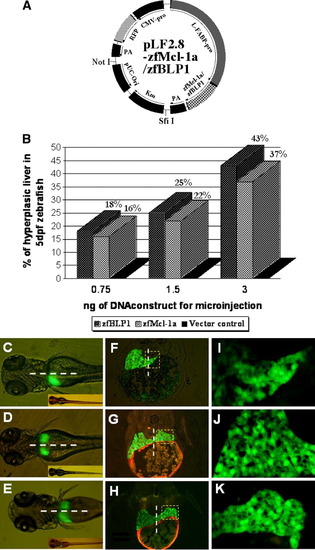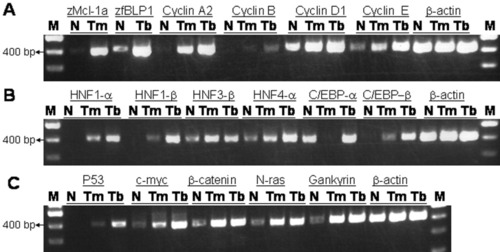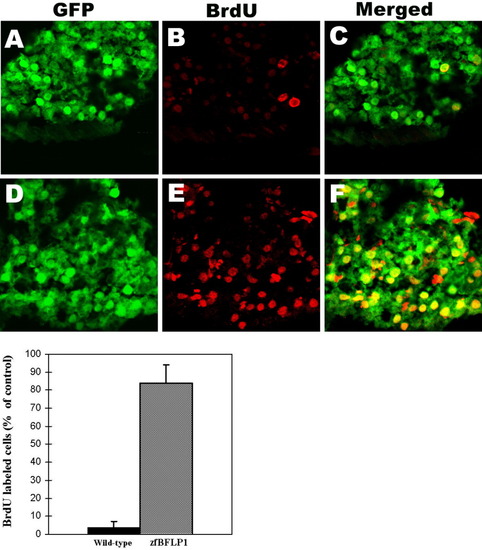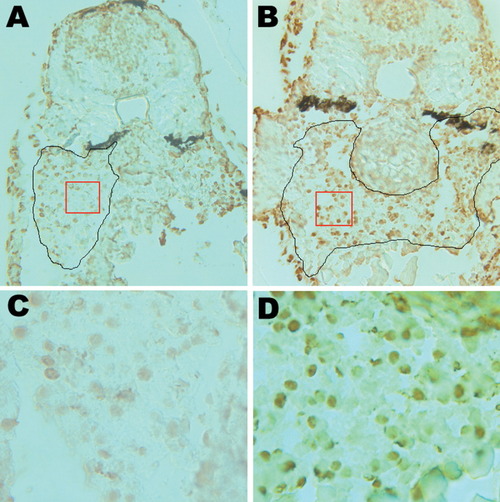- Title
-
Imbalance in liver homeostasis leading to hyperplasia by overexpressing either one of the Bcl-2-related genes, zfBLP1 and zfMcl-1a
- Authors
- Her, G.M., Cheng, C.H., Hon, J.R., Sundaram, G.S., and Wu, J.L.
- Source
- Full text @ Dev. Dyn.
|
Liver hyperplasia at 5 days postfertilization (dpf) in zebrafish larvae overexpressing either zfMCl-1a or zfBLP1. A: Map of the dual-expression transgenic vectors, pLF2.8-zfBLP1 or zfMcl-1a, containing either zfMCl-1a or zfBLP1 in the same expression vector (pLF2.8). Either zfBLP1 or zfMcl-1a transgene and red fluorescent protein (RFP) marker are respectively driven by the L-FABP and CMV promoters. NotI- and SfiI-digested plasmids were injected into blastomeres at the one-cell stage. To estimate the levels of transgenic expression, an internal marker for monitoring the expression of the zfBLP1 or zfMcl-1a transgene was produced and RFP expression in injected fish was first assayed at 48 hours postfertilization (hpf), and then the different stages of embryonic and larval liver development were examined. B: Percentage of hyperplastic liver in 5 dpf zebrafish larvae overexpressing zfBLP1/zfMCl-1a. There were no significant differences between control zebrafish larvae and larvae overexpressing zfBLP1 or zfMCl-1a until 4-5 dpf. Significant instances of hyperplastic liver of zebrafish larvae overexpressing zfBLP1 or zfMCl-1a were observed after the 5 dpf stage. C-K: Comparison of liver phenotype between zebrafish larvae overexpressing zfBLP1 or zfMCl-1a and wild-type fish. C: The liver (arrowhead) in normal LF2.8-TG1 larvae is located to the left of the midline. D,E: The liver (arrowhead) in zebrafish larvae at 5 dpf overexpressing either zfMCl-1a (D) or zfBLP1 (E) was located symmetrically across the midline. Insets in C, D, and E show low-magnification images of whole LF2.8-TG1 larvae, demonstrating the absence of gross body abnormalities. F,H: Transverse sections through normal and hyperplastic liver larvae. The dorsal direction is toward the top, and the left side is toward the right. The normal liver is left of the midline in the section. G: The figures clearly show how the liver can be located symmetrically with respect to the midline in zebrafish larvae at 5 dpf when overexpressing either zfMCl-1a (G) or zfBLP1 (H). I-K: Higher-magnification images of green fluorescent protein (GFP) -labeled liver cells (hepatocytes) clearly showing normal cell morphology and density in the liver of normal larvae (I) and larvae overexpressing either zfMCl-1a (J) or zfBLP1 (K). |
|
Reverse transcriptase-polymerase chain reaction (RT-PCR) analysis of cyclin (A2, B, D1, and E), liver-enriched transcription factor (HNF-1α, HNF-1β, HNF-3β, HNF-4α, C/EBP-α, and C/EBP-β, and oncogene (p53, c-myc, N-ras, gankyrin, and β-catenin) transcripts in normal (N) and hyperplastic liver overexpressing either zfMcl-1a (Tm) or zfBFLP1 (Tb) in 5 days postfertilization (dpf) zebrafish larvae. A: Up-regulation of zebrafish cyclin A2, D1, and E was observed in zfMcl-1a-expressing hyperplastic liver, and up-regulation of A2, B, D1, and E was observed in zfBFLP1-expressing hyperplastic liver, whereas only cyclin E mRNA was detected in normal liver. B: Up-regulation of zebrafish HNF-1α, HNF-1β, HNF-3β, HNF-4α, and C/EBP-β was observed in zfMcl-1a- and zfBFLP1-expressing hyperplastic livers, whereas down-regulation of C/EBP-β mRNA was detected in zfMcl-1a-expressing hyperplastic liver. C: Up-regulation of zebrafish p53, c-myc, N-ras, gankyrin, and β-catenin was observed in either zfBFLP1 or zfMcl-1a-expressing hyperplastic liver, whereas up-regulation of p53 mRNA detected in zfMcl-1a-expressing hyperplastic liver was not significant; β-actin was used as an internal positive control. zfMcl-1a (A, lane 3) and zfBFLP1 (A, lane 5) mRNA showed very strong expression in 5 dpf hyperplastic liver, whereas very faint expression of zfMcl-1a mRNA (A, lane 2) and a trace expression of zfBFLP1 mRNA (A, lane 4) were found in normal liver. |
|
zfBLP1 overexpression promotes DNA synthesis in the hyperplastic liver. A-F: BrdU (5-bromo-2' deoxyuridine) incorporation in normal liver (A-C) of 5 dpf wild-type zebrafish larvae and hyperplastic liver (D-F) of 5 days postfertilization (dpf) zebrafish larvae overexpressing zfBLP1. Comparison of the normal (A) and hyperplastic liver (D) of 5 dpf zebrafish larvae revealed an increased an increased number of cells undergoing DNA replication in the hyperplastic liver where zfBLP1 is overexpressed (E,F). G: For quantification of BrdU-labeled cells, immunofluorescent staining with anti-BrdU monoclonal antibody for hepatocyte that had undergone DNA synthesis, all cells were counterstained with GFP fluorescence to allow quantification of the total number of cells in the same microscopic field. |
|
zfBLP1 overexpression promotes programmed cell death in the hyperplastic liver. A,B: Detection of apoptotic cells in normal liver (A) of 5 days postfertilization (dpf) wild-type zebrafish larvae and hyperplastic liver (B) of 5 dpf zebrafish larvae overexpressing zfBLP1 by the terminal deoxynucleotidyl transferase-mediated deoxyuridine triphosphate nick end-labeling (TUNEL) assay. C,D: Comparison of the normal (C) and hyperplastic liver (D) of 5 dpf zebrafish larvae revealed an increased level of cell death in the expanded lobe of the hyperplastic liver where zfBLP1 is overexpressed. |




